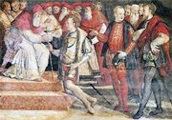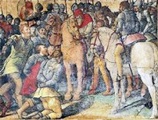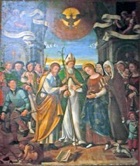Lattanzio Pagani, who came from Monterubbiano in the March of Ancona, was an important artist who worked for Pope Paul III and the papal legates in Umbria. His father, the artist Vincenzo Pagani, was occasionally also documented in Umbria (see below).
Lattanzio seems to have been based in Perugia from ca. 1543, and to have had a close relationship with Cardinal Tiberio Crispo (the papal legate in 1545-8), and seems to have co-ordinated the work of a number of other “foreign” artists who were commissioned at this time to put a papal stamp on the newly defeated city.
Lattanzio seems to have ceased to work as an artist from 1553, when he became Capitano delle Milizie (Captain of the Militia) of the provinces of Umbria and the Marche. He probably remained in Perugia for a period thereafter: his son, Paolo received a doctorate in law there in 1567. He probably left Perugia in 1573, when he became Bargello (Chief of Police) in Rome. He subsequently retired to his native town, where he died.
Foligno
Frescoes in Palazzo Trinci (ca. 1546)
The surviving frescoes on the walls of the Sala di Sisto IV in Palazzo Trinci depict the arms of four of the papal legates to Perugia under Pope Paul III:
-
✴Ippolito de’ Medici (1529-35, north wall);
-
✴Marino Grimani (1535-9, west wall);
-
✴Ascanio Parisani (1542-5, south wall); and
-
✴Tiberio Crispo (1545-8, south wall).
These frescoes were probably commissioned for the visit of Paul III in 1546. The scholar Durante Dorio, who lived in the latter part of the 16th century, attributed the arms of Tiberio Crispo to Lattanzio Pagani. This attribution is difficult to substantiate because the frescoes were heavily over-painted in 1920. However, as noted above, Lattanzio was very close to Cardinal Crispo at this time, so it is entirely possible that he and his associates were entrusted with the decoration of this room ahead of the papal visit.
Perugia
In addition to this own works described below, Lattanzio Pagani is documented in 1547 in relation to the work of Giovanni Battista Caporali in the Chiesa di Montemorcino, which he formally valued, together with Dono Doni.
Frescoes in Rocca Paolina (1543-4)
Giorgio Vasari reports that Lattanzio Pagani began the decoration of the newly built Rocca Paolina. Cristofano Gherardi, il Doceno (who was a close associate of Vasari) “not only assisted ... Lattanzio, but afterwards executed with his own hand the greater part of the best works that are painted in the apartments of that fortress, in which there also worked Raffaellino del Colle and Adone [Dono] Doni of Assisi, an able and well-practised painter .... Tommaso [Bernabei, il] Papacello also worked there ...”
This is the only surviving record of the commissioning of the frescoes of Rocca Paolina. Paul III had built the fortress after his subjugation of the rebellious Perugians in 1540, so it is unsurprising that the team included no Perugian artists: indeed, apart from Dono Doni, all the artists came from outside Umbria. They were to spearhead the introduction of Mannerist art to the city of Perugino. Unfortunately, all of their work here was lost when the fortress was demolished in 1860.
Vasari is explicit the work had been commissioned by “Messer Tiberio Crispo, who was governor and castellan at that time”. A number of considerations suggest that the time in question was 1543-4:
-
✴Serafino Siepi, who described the surviving and frescoes in his guide of 1822, says that those in the chapel (which he attributed to Dono Doni) were dated by inscription to 1543;
-
✴Giorgo Vasari says that he called Cristofano Gherardi from Perugia to Rome in 1543, where he stayed for “many months”;
-
✴Raffaellino del Colle is documented in Perugia in June 1544;
-
✴Tiberio Crispo became a cardinal in December 1544, after which the title “Messer” would have been inappropriate; and
-
✴Giorgio Vasari called Cristofano Gherardi and Raffaellino del Colle (whom he describes as his “friends and pupils”) to Naples in 1545, albeit that Cristofano was too ill to respond.
If this is correct, Vasari’s reference to Tiberio Crispo as “governor and castellan” was either incorrect or perhaps was a reference to Tiberio Crispo’s position at Castel Sant’ Angelo, Rome in 1542-5. He energetically promoted the decoration of the Roman fortress during his tenure, and might also have had responsibilities at Rocca Paolina before his appointment as Cardinal Legate of Perugia (1545-8).
Scenes from the Life of Braccio Fortebracci (1547-8)


Cardinal Tiberio Crispo commissioned these frescoes in the frieze around the Sala della Congregazione Governativa of Palazzo dei Priori (now Room 18 of the Galleria Nazionale). They are attributed to Tommaso Bernabei, il Papacello and sometimes also to Lattanzio Pagani.
The frescoes depict:
-
✴Pope John XXIII conferring the fiefdom of Montone, the governorship of Bologna and the baton of command of papal forces on Braccio in 1410 (a detail of which is illustrated above, on the left);
-
✴Braccio’s victory at the Battle Sant' Egidio in 1416, after which he became Lord of Perugia (a detail of which is illustrated above, on the right);
-
✴the investiture of Braccio as Prince of Capua in 1424; and
-
✴the Battle of l’ Aquila (1424), in which Braccio was defeated by papal forces, and after which he died as a prisoner of war.
In the two scene illustrated above, the figure of Braccio is actually a portrait of Pope Paul III, who had taken Perugia in 1540. Thus, although these scenes ostensibly celebrate Braccio’s achievements, they also depict his ultimate defeat and the more recent defeat of Perugia at the hands of the papacy.
Santa Margherita Altarpiece (1547-9)
This altarpiece from the Camaldolesian nunnery of Santa Margherita was the subject of three payments made in 1547-8 to Lattanzio Pagani and the otherwise unknown Organtino di Mariano. The date 1549 appears in the inscription. The nunnery was suppressed in 1810 and demolished in 1815, and the altarpiece is now in the deposit of the Galleria Nazionale:
-
✴The main panel, which depicts the Madonna and Child enthroned with SS Benedict and Bernard, is not thought to be the work of Lattanzio Pagani, and is thus presumably by Organtino di Mariano.
-
✴The predella, which depicts the martyrdom of St Margaret and figures of SS Christopher and Catherine of Alexandria, is usually attributed solely to Lattanzio Pagani.
Santa Maria del Popolo Altarpiece (1548-9)

Giorgio Vasari, who records this commission, adds that Cristofano Gherardi, il Doceno “painted with his own hands all the upper part, which is indeed most beautiful and worthy of great praise”. There is no documentary evidence of this assertion, but it is supported on stylistic grounds. (The two artists had already worked together at Rocca Paolina - see above).
-
✴In the upper part of the altarpiece, the Madonna is surrounded by angels and seated on a cloud. She holds the standing baby Jesus and is flanked by SS Herculanus and Laurence.
-
✴Below, the citizens of Perugia are assembled in front of a church in a landscape. While this church was probably meant to represent Santa Maria del Popolo, it is actually a direct quotation from a fresco (ca. 1525) of a scene from the life of St Catherine of Siena in Silvestro al Quirinale, Rome, which is by Polidoro da Caravaggio and Maturino da Firenze.
Trinity with the Virgin and Saints (1553)
In 1553, Lattanzio Pagani signed an undertaking with Sforza di Lionello degli Oddi, according to which he agreed to ensure that his father, Vincenzo Pagani and Tommaso Bernabei, il Papacello would paint this altarpiece for the Cappella degli Oddi in San Francesco al Prato. The undertaking specified the presence of SS Francis, Antony of Padua, John the Baptist and Bernardino of Siena, although only the first three of these appeared in the delivered work. It was transferred to the Galleria Nazionale in 1863 and is now the deposit there. Although its poor condition makes attribution difficult, it is generally thought to be largely the work of il Papacello.
Terni
Marriage of the Virgin (16th century)




